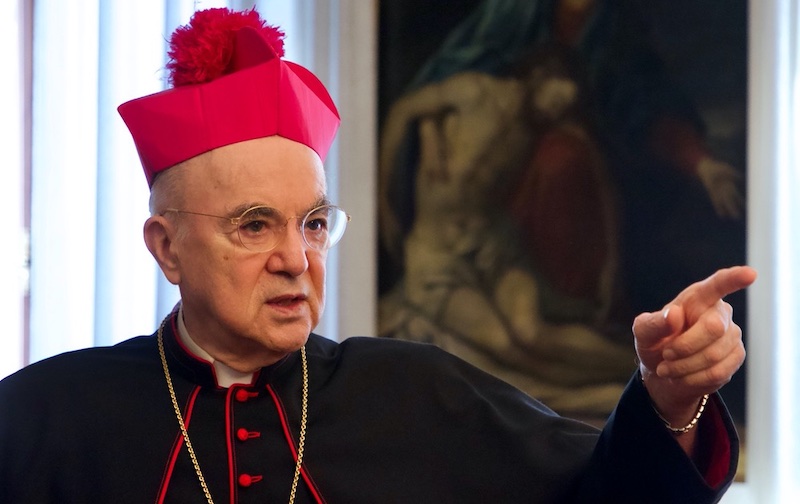by Archbishop Carlo Maria Viganò, LifeSite News:
 In the media dramatization, the actors Ratzinger and Bergoglio have been presented to us as bearers of antithetical theologies, when in reality they represent two successive stages of the same revolutionary process.
In the media dramatization, the actors Ratzinger and Bergoglio have been presented to us as bearers of antithetical theologies, when in reality they represent two successive stages of the same revolutionary process.
THE ‘DISASSEMBLED’ PAPACY
Emeritus. munus, ministerium
The never-ending saga of the Resignation of Benedict XVI continues to fuel an increasingly bold and surreal narrative of the events we have witnessed in the last decade. Inconsistent theories not supported by any evidence have taken hold of many of the faithful and even some priests, increasing confusion and disorientation. But if this has been possible, it is also largely due to those who, knowing the truth, nonetheless are afraid to speak about it because of the consequences that the truth, once revealed, could have. In fact, there are those who believe it is preferable to shore up a castle of lies and deceit, rather than having to face questions about a past of connivance, silence, and complicity.
TRUTH LIVES on at https://sgtreport.tv/
The exchange of letters
During a meeting at the Renaissance Mediterraneo Hotel in Naples with Catholics from the local Cœtus Fidelium held this past November 22 [2024], Msgr. Nicola Bux mentioned an exchange of letters with “Pope Emeritus Benedict XVI,” dating back to the summer of 2014, which supposedly constitute the definitive denial of the various theories that are out there about the invalidity of Benedict’s Renunciation. The content of these letters – the first, written by Msgr. Bux on July 19, 2014 (three pages), and the second, by Benedict XVI, on August 21, 2014 (two pages) – was not released ten years ago, as would have been more than desirable. Instead, only today has their existence been barely mentioned. It so happens that I am aware of both this exchange of letters as well as their content.
Why did Msgr. Bux decide not to promptly disclose Benedict XVI’s response when Benedict was still alive and able to confirm and corroborate it, and instead to reveal only its existence, without disclosing its content, almost two years after his death? Why would he hide this authoritative and very important declaration from the Church and the world?
The permanent revolution
To answer these legitimate questions, we must put aside the fiction given us by the media. We must first understand that the antithetical vision of a “santo subito” [immediate saint] Ratzinger and an “ugly and bad” Bergoglio is convenient for many. This simplistic, artificial, and false approach avoids addressing the heart of the problem, that is, the perfect coherence of action of the “conciliar popes” from John XXIII and Paul VI to the self-styled Francis, including John Paul II and Benedict XVI. The goals are the same, even if pursued with different methods and language. The image of an elderly, elegant, and refined theologian, in a Roman chasuble and red shoes , who granted citizenship to the Tridentine Rite, contrasted with an intemperate globalist heresiarch who does not celebrate Mass and has nullified Summorum Pontificum, while promulgating the Mayan liturgy with thurifying females, is part of that operation of forced polarization that we have also seen adopted in the civil sphere, where a similar subversive project has been carried out by favoring ultra-progressive forces on the one hand and keeping the voices of dissent quiet on the other.
In reality, Ratzinger and Bergoglio – and this is precisely what conservatives do not want to recognize – constitute two moments of a revolutionary process that contemplates alternating phases that are only apparently opposed to one another, following the Hegelian dialectic of thesis, antithesis, and synthesis. A process that did not begin with Ratzinger and will not end with Bergoglio, but rather that goes back to Roncalli and seems destined to continue as long as the deep church continues to replace the Catholic Hierarchy by usurping its authority.
In the Ratzingerian vision, the thesis of the Vetus Ordo and the antithesis of the Novus Ordoare combined in the synthesis of Summorum Pontificum, thanks to the subterfuge of “a single rite in two forms.” But this “peaceful coexistence” is the product of German idealism; and it is false because it is based on the denial of the incompatibility between two ways of conceiving the Church, one corresponding to two thousand years of Catholicism, the other imposed by the Second Vatican Council thanks to the work of heretics who until then had been condemned by the Roman Pontiffs.
The ‘redefinition’ of the papacy
We find the same modus operandi in the intention expressed first by Paul VI, then by John Paul II, and finally by Benedict XVI to “redefine” the Papacy in a collegial and ecumenical way, ad mentem Concilii, where the divine institution of the Church and the Papacy (thesis) and the heretical demands of the neo-modernists and the non-Catholic sects (antithesis) are combined in the synthesis of a redefinition of the Papacy in an ecumenical way, proposed by the encyclical Ut Unum Sint promulgated by John Paul II in 1995 and more recently formulated in the Study Document of the Dicastery for Promoting Christian Unity issued this past June 13 [2024]: The Bishop of Rome. Primacy and Synodality in Ecumenical Dialogues and in the Responses to the Encyclical ‘Ut Unum Sint’. It will not be surprising to learn – as Cardinal Walter Brandmüller confided to me in January 2020 in response to a specific question of mine – that Professor Joseph Ratzinger was developing the theory of the Pope Emeritus and a collegial [shared] Papacy with his colleague Karl Rahner in the 1970s when they were both “young theologians.”





